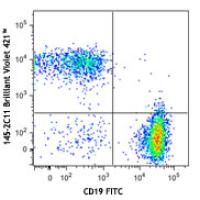-
Sign In
-

-
 Sony Biotechnology
Sony Biotechnology
-

-
 Sony Biotechnology
Sony Biotechnology
Brilliant Violet 421™ anti-mouse CD3ε
Antibodies Single
Sony
145-2C11
Flow Cytometry,Immunohistochemistry
Hamster IgG
Mouse
H-2Kb-specific mouse cytotoxic T lymphocyte clone BM10-37
1101705
$267.00
Description
CD3ε is a 20 kD transmembrane protein, also known as CD3 or T3. It is a member of the Ig superfamily and primarily expressed on T cells, NK-T cells, and at different levels on thymocytes during T cell differentiation. CD3ε forms a TCR complex by associating with the CD3δ, γ and ζ chains, as well as the TCR α/β or γ/δ chains. CD3 plays a critical role in TCR signal transduction, T cell activation, and antigen recognition by binding the peptide/MHC antigen complex.
Formulation
Phosphate-buffered solution, pH 7.2, containing 0.09% sodium azide and BSA (origin USA).Recommended Usage
Each lot of this antibody is quality control tested by immunofluorescent staining with flow cytometric analysis. For immunofluorescent staining using the microg size, the suggested use of this reagent is ≤0.25 microg per million cells in 100 microL volume. For immunofluorescent staining using the microL sizes, the suggested use of this reagent is ≤5 microL per million cells or 5 microL per 100 microL of whole blood. It is recommended that the reagent be titrated for optimal performance for each application.
Brilliant Violet 421™ excites at 405 nm and emits at 421 nm. The standard bandpass filter 450/50 nm is recommended for detection. Brilliant Violet 421™ is a trademark of Sirigen Group Ltd.
This product is subject to proprietary rights of Sirigen Inc. and is made and sold under license from Sirigen Inc. The purchase of this product conveys to the buyer a non-transferable right to use the purchased product for research purposes only. This product may not be resold or incorporated in any manner into another product for resale. Any use for therapeutics or diagnostics is strictly prohibited. This product is covered by U.S. Patent(s), pending patent applications and foreign equivalents.
References
1. Leo O, et al. 1987. P. Natl. Acad. Sci. USA 84:1374. (IP, Activ)
2. Kruisbeek AM, et al. 1991. In Current Protocols in Immunology. 3.12.1. (Activ)
3. Duke RC, et al. 1995. Current Protocols in Immunology. 3.17.1.
4. Salvadori S, et al. 1994. J. Immunol. 153:5176. (WB)
5. Payer E, et al. 1991. J. Immunol. 146:2536. (IF)
6. Jacobs H, et al. 1994. Eur. J. Immunol. 24:934. (CMCD)
7. Vossen ACTM, et al. 1995. Eur. J. Immunol. 25:1492. (Activ)
8. Henrickson M, et al. 1995. Transplantation 60:828. (Deplete)
9. Kinnaert P, et al. 1996. Transpl. Int. 9:386. (Deplete)
10. Han WR, et al. 1999. Transpl. Immunol. 7:207. (Deplete)
11. Miescher GC, et al. 1989. Immunol. Lett. 23:113. (Block)
12. Terrazas LI, et al. 2005. Intl. J. Parasitology. 35:1349. (Activ)
13. Ko SY, et al. 2005. J. Immunol. 175:3309.
14. Podd BS, et al. 2006. J. Immunol. 176:6532. (IHC)
15. Tilley SL, et al. 2007. J. Immunol. 178:3208. (IHC)
16. Wang W, et al. 2007. J. Immunol. 178:4885. (Activ)
17. Xiao S, et al. 2007. J. Exp. Med. 204:1691.
18. Chappaz S, et al. 2007. Blood doi:10.1182/blood-2007-02-074245. (FC) PubMed.
19. Curtsinger JM, et al.2005. J. Immunol. 175:4392. PubMed
20. Guo Y, et al. 2008. Blood 112:480. PubMed
21. Kenna TJ, et al. 2008. Blood 111:2091.
22. Perchonock CE, et al. 2007. J. Immunol. 179:1768. PubMed
23. Perchonock GE, et al. 2006. Mol. Cell. Biol. 26:6005. PubMed
24. Kanaya T, et al. 2008. Am. J. Physiol. Gastrointest. Liver Physiol. 295:G273. PubMed
25. de Koning BA, et al. 2006. Int. Immunol. 18:941. PubMed
26. Schulteis RD, et al. 2008. Blood 295:G273. PubMed
27. Qi Q, et al. 2009. Blood 114:564. PubMed
28. Helmersson S, et al. 2013. Am J Pathol. 9440:123. Pubmed
29. Wu S, et al. 2014. Clin Vaccine Immunol. 21:156. PubMed
30. Yan J, et al. 2014. Vaccine. 32:2833. PubMed
31. Guiterrez DA, et al. 2014. Diaebetes. 63:3827. PubMed


